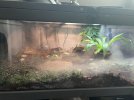You are using an out of date browser. It may not display this or other websites correctly.
You should upgrade or use an alternative browser.
You should upgrade or use an alternative browser.
Help! Brainstorm for my Redfooted Tortoise. I live in Utah
- Thread starter OogwayTorti
- Start date
OogwayTorti
New Member
I do have a reptile humidifier going basically all day. Oogway has been eating, and doing good im just worried about temperature and humidity. I currently have 2 ceramic heat emitters to get the temps up.
OogwayTorti
New Member
I do have a reptile humidifier going basically all day. Oogway has been eating, and doing good im just worried about temperature and humidity. I currently have 2 ceramic heat emitters to get the temps up.
Attachments
Hello and welcome!I do have a reptile humidifier going basically all day. Oogway has been eating, and doing good im just worried about temperature and humidity. I currently have 2 ceramic heat emitters to get the temps up.
Please understand that we are all glad you are here asking for help and the following is intended to inform and help you.
I wish someone had told you before me that this species is totally unsuitable for your environment. Sounds like someone wanted to make a sale unfortunately. They also sold you the wrong enclosure and the wrong heating and lights for this species. You can raise a baby in your climate with no problem IF you buy or build a large closed chamber. Open topped enclosures do not work. That is like trying to heat your house in winter with no roof. Its just physics. It can't work. You need a closed chamber with all the heating and lighting inside to contain all your heat and humidity.
Humidifiers should not be blowing directly into tortoise enclosures. Its not good for them to be breathing those little microdroplets, and that is not the same as humidity anyway. They can be used to humidify the whole room, but that isn't going to help the inside of an open topped enclosure much.
The real trouble will be when this guy outgrows the 4x8 foot large closed chamber and needs a room sized enclosure that is warm and humid 24/7 all year long. They need South Florida weather, not Utah or SoCal weather.
Here is the care info for your species, followed by a bunch of general care info:
Redfoot Tortoise Care Sheet
NOTE: I do not keep redfoots, and I only have one tortoise in total. With this in mind, remember that I am in no way an expert, and this should not be used as cold hard proof of how to raise a redfoot. I used information from great keepers on this forum to put everything together. This care...
Info For New People. Please Read This First.
Hello and welcome to tortoiseforum.org! We are all glad you are here! There is no other forum like this anywhere. We have tens of thousands of members from all over the world ranging from kids with their first tortoise to people who have been breeding and keeping high end tortoises since the...
Questions are welcome. I'm certain this is not what you wanted to hear, but better you hear it now than learn it the hard way months from now after all the damage has been done.
OogwayTorti
New Member
Thank you! Idk why she made me feel 100% this would be ok. I don’t want to harm the little guy/girl and knowing how hard and dry it is here I will start looking to re-home him/her to a better environment suited for. Thank you for your honesty. Since I have you here would you suggest a Russian for my climate in Utah?Hello and welcome!
Please understand that we are all glad you are here asking for help and the following is intended to inform and help you.
I wish someone had told you before me that this species is totally unsuitable for your environment. Sounds like someone wanted to make a sale unfortunately. They also sold you the wrong enclosure and the wrong heating and lights for this species. You can raise a baby in your climate with no problem IF you buy or build a large closed chamber. Open topped enclosures do not work. That is like trying to heat your house in winter with no roof. Its just physics. It can't work. You need a closed chamber with all the heating and lighting inside to contain all your heat and humidity.
Humidifiers should not be blowing directly into tortoise enclosures. Its not good for them to be breathing those little microdroplets, and that is not the same as humidity anyway. They can be used to humidify the whole room, but that isn't going to help the inside of an open topped enclosure much.
The real trouble will be when this guy outgrows the 4x8 foot large closed chamber and needs a room sized enclosure that is warm and humid 24/7 all year long. They need South Florida weather, not Utah or SoCal weather.
Here is the care info for your species, followed by a bunch of general care info:
Redfoot Tortoise Care Sheet
NOTE: I do not keep redfoots, and I only have one tortoise in total. With this in mind, remember that I am in no way an expert, and this should not be used as cold hard proof of how to raise a redfoot. I used information from great keepers on this forum to put everything together. This care...tortoiseforum.org
Info For New People. Please Read This First.
Hello and welcome to tortoiseforum.org! We are all glad you are here! There is no other forum like this anywhere. We have tens of thousands of members from all over the world ranging from kids with their first tortoise to people who have been breeding and keeping high end tortoises since the...tortoiseforum.org
Questions are welcome. I'm certain this is not what you wanted to hear, but better you hear it now than learn it the hard way months from now after all the damage has been done.
Yes. A Russian would be WAAAAAYYYYY better. I think you can keep desert tortoises in Utah too, can't you? Or am I confusing that with Nevada....Thank you! Idk why she made me feel 100% this would be ok. I don’t want to harm the little guy/girl and knowing how hard and dry it is here I will start looking to re-home him/her to a better environment suited for. Thank you for your honesty. Since I have you here would you suggest a Russian for my climate in Utah?
Russians come from a similarly harsh desert-like environment to Utah, and they can brumate for you in winter. An adult will be relatively easy to house outdoors full time with the right enclosure, if you want, and there are many breeders producing healthy well started babies. You might also find a wild caught adult that someone bought at a pet store, that is in need of a good home.
Here is the care info for Russians:
The Best Way To Raise Any Temperate Species Of Tortoise
I chose the title of this care sheet very carefully. Are there other ways to raise babies and care for adults? Yes. Yes there are, but those ways are not as good. What follows is the BEST way, according to 30 years of research and experimentation with hundreds of babies of many species. What is...
Littleredfootbigredheart
Well-Known Member
Hello and welcome to the forum!🥰
Unfortunately as Tom has said, you’ve been sold the wrong kind of set up here.
I’m going to include some information below on examples of the correct kind of equipment to use and levels etc, hopefully it helps!
If using a light emitting heat source it should be an incandescent floodlight(example attached)on a 12 hour timer, using a CHE(ceramic heat emitter) for night heat.
However I think ceramics as a heat source are more suited to red foot’s and far less desiccating on their shells.
Red foot’s don’t necessarily need a ‘basking area’ they aren’t typically a basking species coming from the forest floor(some do though, it depends on the individual) there’s no need for a ‘cooler end’ and ‘warmer end’ with these guys, aim for an overall ambient temperature range of 80-86(82-84 being optimal)temps shouldn’t ever be going below 80 for one as young as yours both night&day.
Personally we rely on CHE’s(ceramic heat emitters) as our heat source 24/7, on thermostats, they’re a non light emitting bulb and I think you’ll find it easier switching to these as your heat source to keep your temps nice and stable. When using multiple hang them equal distance to distribute the heat more evenly.
Dome fittings will help project the heat down, but don’t rely on the clamps that come with them, always hang them securely.
You can then hang some ambient lighting on a 12hour timer, it can being either a led strip or a led bulb in 5000k-65000k colour range. Create lots of shady areas with safe plants and hides, red foots don’t like things too bright.
Any indoor UV needs to be provided as a t5 tube fluorescent light, the compact or all in one bulbs either are too harsh creating uv hot spots that can damage their eyes, or are far too weak. I’ve attached the brands to go for and examples of stands to mount them.
Your little one needs around 80% humidity 24/7 to thrive, the right substrate and a good closed chamber set up goes a long way in making this work. You’ll constantly struggle with an open top like this.
We personally keep our red foot on orchid bark, we focus on the under layer of the substrate being nice and damp to create the humidity, then the top layer being dry, the trouble with constantly spraying is, one, it can only lasts so long, and two, keeping that top layer constantly damp will leave them more prone to a fungal infection, avoid misters/foggers for this reason too, the humidifiers can also make the air too wet leading to respiratory issues. To stop that top layer getting a little too dry because you don’t want dusty substrate, we mix it now n then, which also helps gives a humidity boost without extra water🙂to maintain our humidity we simply pour some lukewarm water into the corners of the substrate, not loads! Just enough to dampen the whole under layer. You can keep an eye on your monitors&substrate to do the pours as and when needed, which in a good closed chamber set up, you shouldn’t have to do loads😊
Substrate wise never add any kind of moss, that’s something some stores think nothing of, but it can actually cause lethal impactions.
Don’t use any top soils or anything mixed with sand.
Safe substrate options are coco coir, damp and packed down by hand as a base, with orchid bark(fir not pine) on top, or forest floor on top, or just the orchid bark/ forest floor on their own, the coir you’re using is fine if that’s what you want to stick to🙂
The size you’re using will last you a bit if you can put a greenhouse topper over it. But a good cost effective closed chamber set up moving forward would be a greenhouse style enclosure by making your own large base out of a safe material, or even use a garden bed frame! For both these options line with some cheap pond liner, the lining going up the sides too and make sure those sides are high enough. Then simply secure a greenhouse topper on top, if you can’t find an exact fit place it over like the one with the white base in the photo, I’d place some lining under the cover and base though to avoid condensate getting on your floor.
Some people even hang their lighting and heat from the greenhouse frame! Simply wrap the wire around for the height you need(check with a temperature gun/add thermostats, roughly 18-21 inches for the uv) and secure with cable ties. Or you could make your own stands out of safe timber, again I’ll attach some pics.
For a water dish a large terracotta saucer, sitting flush with the substrate is safest, they have grip in the event the tortoise flips, most pet store options are a hazard😕
Id definitely recommend a temp gun to make sure your monitors are reading correctly. Have monitors that read both temp and humidity.
Ignore whatever else is in the photos in the enclosures, they’re just to give you an idea😊and ignore that some of the fittings in the pics are floodlights, ches will work great, just examples on how to hang your bulbs👍
I’ll include a diet list of some stuff we feed ours in my next reply, to hopefully help give you some ideas for variety🙂
Unfortunately as Tom has said, you’ve been sold the wrong kind of set up here.
I’m going to include some information below on examples of the correct kind of equipment to use and levels etc, hopefully it helps!
If using a light emitting heat source it should be an incandescent floodlight(example attached)on a 12 hour timer, using a CHE(ceramic heat emitter) for night heat.
However I think ceramics as a heat source are more suited to red foot’s and far less desiccating on their shells.
Red foot’s don’t necessarily need a ‘basking area’ they aren’t typically a basking species coming from the forest floor(some do though, it depends on the individual) there’s no need for a ‘cooler end’ and ‘warmer end’ with these guys, aim for an overall ambient temperature range of 80-86(82-84 being optimal)temps shouldn’t ever be going below 80 for one as young as yours both night&day.
Personally we rely on CHE’s(ceramic heat emitters) as our heat source 24/7, on thermostats, they’re a non light emitting bulb and I think you’ll find it easier switching to these as your heat source to keep your temps nice and stable. When using multiple hang them equal distance to distribute the heat more evenly.
Dome fittings will help project the heat down, but don’t rely on the clamps that come with them, always hang them securely.
You can then hang some ambient lighting on a 12hour timer, it can being either a led strip or a led bulb in 5000k-65000k colour range. Create lots of shady areas with safe plants and hides, red foots don’t like things too bright.
Any indoor UV needs to be provided as a t5 tube fluorescent light, the compact or all in one bulbs either are too harsh creating uv hot spots that can damage their eyes, or are far too weak. I’ve attached the brands to go for and examples of stands to mount them.
Your little one needs around 80% humidity 24/7 to thrive, the right substrate and a good closed chamber set up goes a long way in making this work. You’ll constantly struggle with an open top like this.
We personally keep our red foot on orchid bark, we focus on the under layer of the substrate being nice and damp to create the humidity, then the top layer being dry, the trouble with constantly spraying is, one, it can only lasts so long, and two, keeping that top layer constantly damp will leave them more prone to a fungal infection, avoid misters/foggers for this reason too, the humidifiers can also make the air too wet leading to respiratory issues. To stop that top layer getting a little too dry because you don’t want dusty substrate, we mix it now n then, which also helps gives a humidity boost without extra water🙂to maintain our humidity we simply pour some lukewarm water into the corners of the substrate, not loads! Just enough to dampen the whole under layer. You can keep an eye on your monitors&substrate to do the pours as and when needed, which in a good closed chamber set up, you shouldn’t have to do loads😊
Substrate wise never add any kind of moss, that’s something some stores think nothing of, but it can actually cause lethal impactions.
Don’t use any top soils or anything mixed with sand.
Safe substrate options are coco coir, damp and packed down by hand as a base, with orchid bark(fir not pine) on top, or forest floor on top, or just the orchid bark/ forest floor on their own, the coir you’re using is fine if that’s what you want to stick to🙂
The size you’re using will last you a bit if you can put a greenhouse topper over it. But a good cost effective closed chamber set up moving forward would be a greenhouse style enclosure by making your own large base out of a safe material, or even use a garden bed frame! For both these options line with some cheap pond liner, the lining going up the sides too and make sure those sides are high enough. Then simply secure a greenhouse topper on top, if you can’t find an exact fit place it over like the one with the white base in the photo, I’d place some lining under the cover and base though to avoid condensate getting on your floor.
Some people even hang their lighting and heat from the greenhouse frame! Simply wrap the wire around for the height you need(check with a temperature gun/add thermostats, roughly 18-21 inches for the uv) and secure with cable ties. Or you could make your own stands out of safe timber, again I’ll attach some pics.
For a water dish a large terracotta saucer, sitting flush with the substrate is safest, they have grip in the event the tortoise flips, most pet store options are a hazard😕
Id definitely recommend a temp gun to make sure your monitors are reading correctly. Have monitors that read both temp and humidity.
Ignore whatever else is in the photos in the enclosures, they’re just to give you an idea😊and ignore that some of the fittings in the pics are floodlights, ches will work great, just examples on how to hang your bulbs👍
I’ll include a diet list of some stuff we feed ours in my next reply, to hopefully help give you some ideas for variety🙂
Attachments
-
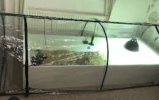 IMG_1674.jpeg60.6 KB · Views: 1
IMG_1674.jpeg60.6 KB · Views: 1 -
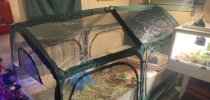 IMG_1675.jpeg104.4 KB · Views: 1
IMG_1675.jpeg104.4 KB · Views: 1 -
 IMG_1672.jpeg84.7 KB · Views: 1
IMG_1672.jpeg84.7 KB · Views: 1 -
 IMG_1670.jpeg65.1 KB · Views: 2
IMG_1670.jpeg65.1 KB · Views: 2 -
 IMG_1871.jpeg238 KB · Views: 1
IMG_1871.jpeg238 KB · Views: 1 -
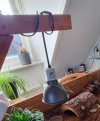 IMG_1872.jpeg48.1 KB · Views: 1
IMG_1872.jpeg48.1 KB · Views: 1 -
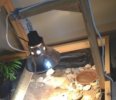 IMG_1873.jpeg32 KB · Views: 1
IMG_1873.jpeg32 KB · Views: 1 -
 IMG_1733.jpeg29.9 KB · Views: 1
IMG_1733.jpeg29.9 KB · Views: 1 -
 IMG_1683.png151.5 KB · Views: 1
IMG_1683.png151.5 KB · Views: 1 -
 IMG_1669.png149.5 KB · Views: 1
IMG_1669.png149.5 KB · Views: 1 -
 IMG_1679.png143.4 KB · Views: 1
IMG_1679.png143.4 KB · Views: 1 -
 IMG_1684.jpeg147 KB · Views: 1
IMG_1684.jpeg147 KB · Views: 1 -
 IMG_1628.png178.4 KB · Views: 1
IMG_1628.png178.4 KB · Views: 1
Littleredfootbigredheart
Well-Known Member
These are some greens to feed(bear in mind the lettuce isn’t the most nutritional but fine to add as part of a varied diet);
Lambs lettuce
Romaine
Red leaf lettuce
Frisèe lettuce
Endive(chicory)
Spring greens
Kale
Rocket
Cress on occasion
The odd Brussel sprout on occasion
There’s also plenty of different weeds you can add! Providing you’re sourcing them from an area that is free of any harmful chemicals like pesticides and fertiliser, so be WARY! There’s lots of lookalikes that can be toxic, it might be best to grow your own from seeds online. We add dandelions and broadleaf plantain, I’ll add a link below you might find useful to look through🙂
Now let’s talk fruit! We remove any pips/seed/stones that are either toxic or a chocking hazard, so for my list, we’d remove the mango stone, plum stone, peach stone, nectarine stone, cherry stones(chocking hazard!), apricot stones, appel&pear seeds(toxic)
Ones we feed more regularly(but rotate cause variety is key):
Mango
Papaya
Pineapple
Raspberries
Melon
Strawberries
Watermelon(not super nutritional but a good hydration boost)
Plum
Peach
Nectarines
Cherries
Apricot
Blueberries
Figs
Guava
Prickly pear
Ones we feel less regularly:
Appel
Banana
Blackberries
Grapes
Pear
Those last ones are more of a treat basis. You can also try cherry tomatoes on occasion but not often.
We also sometimes grate a bit of carrot on our red foots food(not a lot) or some courgette, you can also add bell peppers on occasion, and they’ll also enjoy some mushroom once a week or so!
Hope this helps give you some ideas for variety🙂 we try not to give ours too much of just the one type of fruit in any given week, however she gets papaya pretty much daily, it makes up a large majority of their diet in the wild so definitely get your hands on some!
Also they’ll need some protein every 7-10 days, we personally give ours a head sized protein of steamed chicken breast, or a mouse we defrost from the reptile shop.
Calcium power can be added on 3 feeds a week.
Hope all this helps😊
Lambs lettuce
Romaine
Red leaf lettuce
Frisèe lettuce
Endive(chicory)
Spring greens
Kale
Rocket
Cress on occasion
The odd Brussel sprout on occasion
There’s also plenty of different weeds you can add! Providing you’re sourcing them from an area that is free of any harmful chemicals like pesticides and fertiliser, so be WARY! There’s lots of lookalikes that can be toxic, it might be best to grow your own from seeds online. We add dandelions and broadleaf plantain, I’ll add a link below you might find useful to look through🙂
The Tortoise Table - Home
The Tortoise Table plant database and resource site for Tortoise owners
www.thetortoisetable.org.uk
Now let’s talk fruit! We remove any pips/seed/stones that are either toxic or a chocking hazard, so for my list, we’d remove the mango stone, plum stone, peach stone, nectarine stone, cherry stones(chocking hazard!), apricot stones, appel&pear seeds(toxic)
Ones we feed more regularly(but rotate cause variety is key):
Mango
Papaya
Pineapple
Raspberries
Melon
Strawberries
Watermelon(not super nutritional but a good hydration boost)
Plum
Peach
Nectarines
Cherries
Apricot
Blueberries
Figs
Guava
Prickly pear
Ones we feel less regularly:
Appel
Banana
Blackberries
Grapes
Pear
Those last ones are more of a treat basis. You can also try cherry tomatoes on occasion but not often.
We also sometimes grate a bit of carrot on our red foots food(not a lot) or some courgette, you can also add bell peppers on occasion, and they’ll also enjoy some mushroom once a week or so!
Hope this helps give you some ideas for variety🙂 we try not to give ours too much of just the one type of fruit in any given week, however she gets papaya pretty much daily, it makes up a large majority of their diet in the wild so definitely get your hands on some!
Also they’ll need some protein every 7-10 days, we personally give ours a head sized protein of steamed chicken breast, or a mouse we defrost from the reptile shop.
Calcium power can be added on 3 feeds a week.
Hope all this helps😊
- Joined
- Jul 16, 2014
- Messages
- 29,375
- Location (City and/or State)
- South Eastern Florida (U.S.A.)/Rock Hill S.C.
All excellent advice!These are some greens to feed(bear in mind the lettuce isn’t the most nutritional but fine to add as part of a varied diet);
Lambs lettuce
Romaine
Red leaf lettuce
Frisèe lettuce
Endive(chicory)
Spring greens
Kale
Rocket
Cress on occasion
The odd Brussel sprout on occasion
There’s also plenty of different weeds you can add! Providing you’re sourcing them from an area that is free of any harmful chemicals like pesticides and fertiliser, so be WARY! There’s lots of lookalikes that can be toxic, it might be best to grow your own from seeds online. We add dandelions and broadleaf plantain, I’ll add a link below you might find useful to look through🙂
The Tortoise Table - Home
The Tortoise Table plant database and resource site for Tortoise ownerswww.thetortoisetable.org.uk
Now let’s talk fruit! We remove any pips/seed/stones that are either toxic or a chocking hazard, so for my list, we’d remove the mango stone, plum stone, peach stone, nectarine stone, cherry stones(chocking hazard!), apricot stones, appel&pear seeds(toxic)
Ones we feed more regularly(but rotate cause variety is key):
Mango
Papaya
Pineapple
Raspberries
Melon
Strawberries
Watermelon(not super nutritional but a good hydration boost)
Plum
Peach
Nectarines
Cherries
Apricot
Blueberries
Figs
Guava
Prickly pear
Ones we feel less regularly:
Appel
Banana
Blackberries
Grapes
Pear
Those last ones are more of a treat basis. You can also try cherry tomatoes on occasion but not often.
We also sometimes grate a bit of carrot on our red foots food(not a lot) or some courgette, you can also add bell peppers on occasion, and they’ll also enjoy some mushroom once a week or so!
Hope this helps give you some ideas for variety🙂 we try not to give ours too much of just the one type of fruit in any given week, however she gets papaya pretty much daily, it makes up a large majority of their diet in the wild so definitely get your hands on some!
Also they’ll need some protein every 7-10 days, we personally give ours a head sized protein of steamed chicken breast, or a mouse we defrost from the reptile shop.
Calcium power can be added on 3 feeds a week.
Hope all this helps😊
Redfoot have the largest menu options of any other species. They can eat just about any fresh unprocessed food that you eat.
Feeding one is the easiest part. Or at least it should be.
Redfoot need a 24/7 temperature of 80 to 88. 82 to 84 is the ideal zone.
Complete digestion can't happen well below the mid 70s and Redfoot get uncomfortable past the low 90s. In fact they can overheat in the mid to upper 90s and require lots of shade.
Avoid bright, harsh lighting.
The humidity needs to be over 70% day and night. And the best/easiest and most sensible way to accomplish this is with a closed chamber enclosure. With one you can get away from using any supplemental humidity adders.
COmtnLady
Well-Known Member
Welcome to The Tortoise Forum! This place has the most up-to-date info on how to help your tortoise to thrive. Check with others here before buying things - pet shops will sell you stuff you shouldn't use, and people on Face Book and similar places are running off of old info that is very questionable. Come here first, it will save you grief and money.
I live in Colorado, with similar climate as yours. You need a closed top, no air holes, to keep the temps and humidity right.
As a stop-gap for a day or so, put a sheet of plastic or paper over the open part, basically you want the light to get in, while at the same time, the heat and humidity to not to get out. Check to make sure it isn't emitting fumes, or getting burnt by the light fixtures being too close to it. There are plastic green houses that basically tent over and around your tortoise table, check Home Depot or Lowes, maybe even WalMart. Keep an eye on the temperature, its like putting a lid on a pan on the stove - it will get hotter because its contained.
Soaking is very important! Everyday for twenty minutes or a half hour, in warm water that comes up to where the top and bottom parts of her shell come together. Because it is so shallow you will have to keep a an eye on it not getting cold, plus they can tip themselves over and drown, so watch. (They usually have a bowel movement when in the water, so that needs changed out...)
Also, Red Foots evolved in a forested/jungle place (the equatorial region of South America), so no bright lights - they hurt the tortoise's eyes, and Red Foot aren't "baskers" like other species of tortoise are.. They do need the UVB however because our climate doesn't allow for year round outdoor sunshine exposure.
I started writing before looking at what everyone else said. Listen to them, they're right. Red Foot are easier to feed, (and prettier in my opinion), but our climate means a lot more care will be needed...
Be careful in your re-homing efforts if you decide to change to a Russian or Desert Tort. Some people will grab up whatever animal they can get their hands on, not keep them in suitable conditions, then try to sell them to other people without concern for the animal's well being. If you are giving up the one you have for its best interests, make sure before you let it go that its going to a place that is better than what you can provide. I would suggest finding the nearest tortoise rescue, both for placement if you do decide to re-home yours, and for a more suitable species to adopt if you go that route. Craigslist is a possibility, but frequently animals on there haven't been cared for well and you could be getting into something over your head.
Keep us in the loop as things progress. Tortoises are fascinating creatures, don't be scared away.
I live in Colorado, with similar climate as yours. You need a closed top, no air holes, to keep the temps and humidity right.
As a stop-gap for a day or so, put a sheet of plastic or paper over the open part, basically you want the light to get in, while at the same time, the heat and humidity to not to get out. Check to make sure it isn't emitting fumes, or getting burnt by the light fixtures being too close to it. There are plastic green houses that basically tent over and around your tortoise table, check Home Depot or Lowes, maybe even WalMart. Keep an eye on the temperature, its like putting a lid on a pan on the stove - it will get hotter because its contained.
Soaking is very important! Everyday for twenty minutes or a half hour, in warm water that comes up to where the top and bottom parts of her shell come together. Because it is so shallow you will have to keep a an eye on it not getting cold, plus they can tip themselves over and drown, so watch. (They usually have a bowel movement when in the water, so that needs changed out...)
Also, Red Foots evolved in a forested/jungle place (the equatorial region of South America), so no bright lights - they hurt the tortoise's eyes, and Red Foot aren't "baskers" like other species of tortoise are.. They do need the UVB however because our climate doesn't allow for year round outdoor sunshine exposure.
I started writing before looking at what everyone else said. Listen to them, they're right. Red Foot are easier to feed, (and prettier in my opinion), but our climate means a lot more care will be needed...
Be careful in your re-homing efforts if you decide to change to a Russian or Desert Tort. Some people will grab up whatever animal they can get their hands on, not keep them in suitable conditions, then try to sell them to other people without concern for the animal's well being. If you are giving up the one you have for its best interests, make sure before you let it go that its going to a place that is better than what you can provide. I would suggest finding the nearest tortoise rescue, both for placement if you do decide to re-home yours, and for a more suitable species to adopt if you go that route. Craigslist is a possibility, but frequently animals on there haven't been cared for well and you could be getting into something over your head.
Keep us in the loop as things progress. Tortoises are fascinating creatures, don't be scared away.
Last edited:
Similar threads
- Replies
- 18
- Views
- 2K

